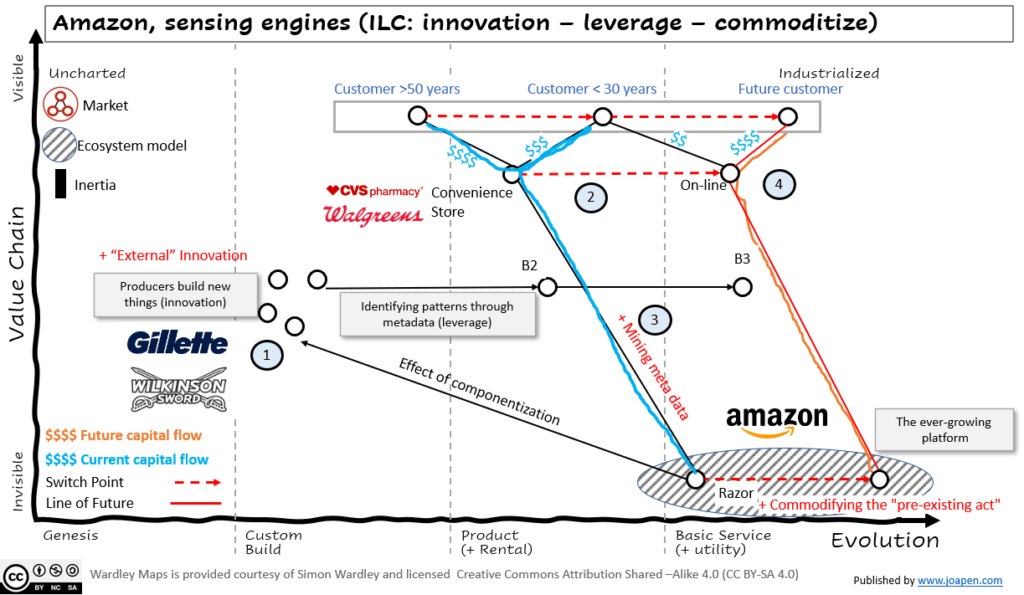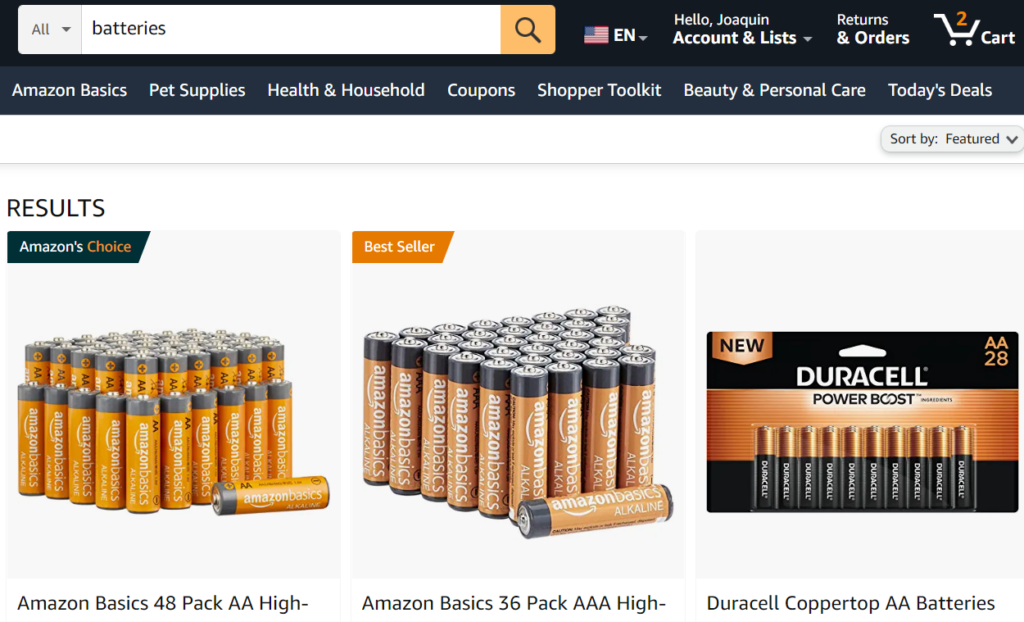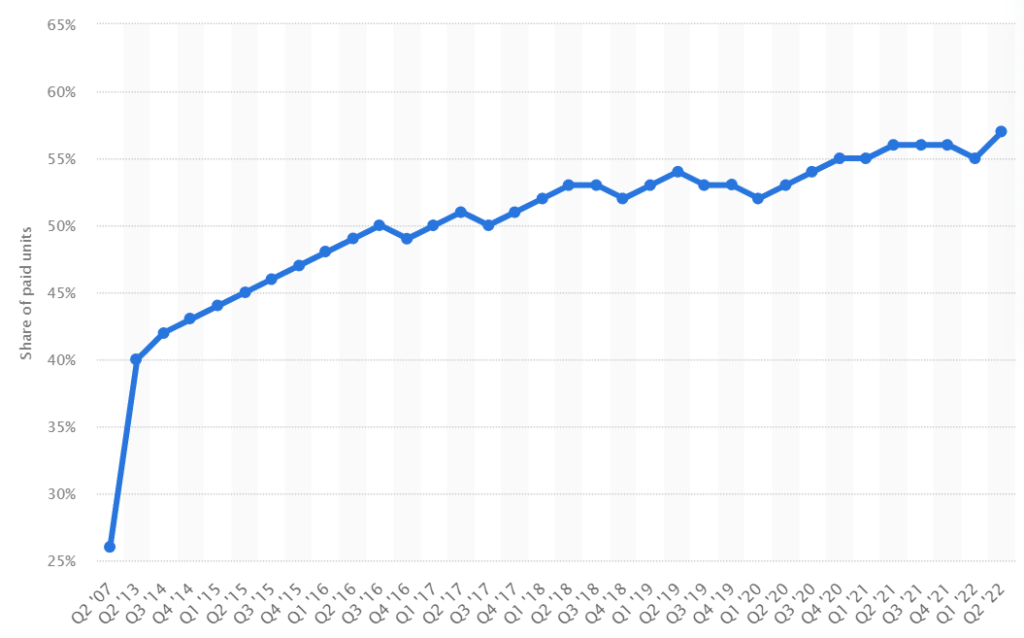This is an example of the gameplay sensing engines, focused on how Amazon does it (basic explanation).
ILC comes from “innovation – leverage – commoditize”,
- Let others to innovate.
- Use metadata to identify patterns (leverage).
- Commoditize the “pre-existing act”.
This is the map:

The summary about the “Amazon, sensing engines” map:
- Point 1: shaving machine manufacturing companies research and try to innovate in order to offer better products to their customers.
- Point 2: supermarkets and convenience stores sell all these products mainly to elderly people who are in the habit of going to them.
- Point 3: Amazon analyzes the consumption data of razors by certain users is a volume that justifies having your own private label.
- Point 4: all this investment is about making future capital flow towards on-line consumption. The habits acquired by the new generations are different from those of older people (regardless of whether they buy the private label or the best on the market).
When you look for “batteries” you will see Amazon’s batteries that belong to Amazon Basis brand. The amount of products sold initially by a brand and later by Amazon Basis grow and grow.

In this way they can add products manufactured by themselves, knowing the amount of sales they have, the stability of prices, and more. All this enables Amazon to negotiate with the manufacturer and listing their products first.
How Amazon does it at their scale?
You probably have asked yourself, how Amazon does it at their scale?
Well, the first answer is they do it through their marketplace, where they sell their products and third party products.
But how are they able to attract too many third parties? Well, with the support of several services they have built for third parties that they want to sell in amazon.com. The main one is Fulfillment by Amazon (FBA), that enable anyone to sell via Amazon locally or globally.
Amazon FBA was launched in September 2006 in United States, now it operates in 19 countries. Under Aamzon you can find sub-services and variants that enable them to cover as much market as possible:
- Fulfillment by Merchant (FBM), where Amazon takes care of the orders and the seller takes care of the rest of the process.
- Retail arbitrage, which has many variants: wholesale, your own brand…
Amazon FBA enables a lot of sales, commissions for Amazon and data that enable them to play “sensing engines”.
With respect the topic of this article, Amazon FBA enables Amazon to play “sensing engines”: listen and capture what is sell, at what price, the frequency etc.
How big is Amazon FBA for Amazon?
Amazon does not add details about the percentage of revenue or benefits that comes from Amazon FBA. In the investors relations area of the web you just can see press release notes where Amazon FBA is mentioned.
Press release notes from 26/April/2018
- Amazon launched Fulfillment by Amazon (FBA) in Australia, offering small and medium-sized businesses selling on Amazon.com.au the ability to leverage the Amazon fulfillment network to better scale and reach more customers.
Press release notes from 1/February/2018
- Fulfillment by Amazon (FBA) shipped billions of items for small and medium-sized businesses, selling on Amazon worldwide in 2017.
Press release notes from 2/February/2017
- Fulfillment by Amazon (FBA) delivered more than two billion units on behalf of sellers in 2016, and the number of active sellers using FBA grew more than 70%. Using the FBA service, Amazon sellers from more than 130 countries fulfilled orders to customers in 185 countries.
- In 2016, there were over 100,000 sellers with sales of more than $100,000 selling on Amazon.
- In the fourth quarter, FBA units represented more than 55% of total third-party units.
Press release notes from 23/July/2015
- Customers purchased more units on Prime Day than Black Friday 2014, and saved millions of dollars on deals around the world. Sellers using Fulfillment by Amazon (FBA) also benefited, experiencing record-breaking unit sales on Prime Day.
- Amazon introduced the FBA Small and Light program, a new fulfillment solution for fast-moving, small, and light products that increases free shipping selection for customers and provides a low-cost shipping option for sellers.
- Amazon also launched Selling on Amazon and FBA in Mexico, allowing third-party sellers to list and sell their products at Amazon.com.mx.
- Amazon.in introduced Sunday delivery across 100 cities in India for all FBA products at no additional cost.
Data from other sources
There is data from other sources, but they are not official ones, so I have some doubts about it. For instance, Statista publishes this chart, that gives you an idea how powerful it is:

All has not been easy
All this has not been easy, Amazon has been many years with low earnings. The long term view of Amazon is not something that Wall Street understood till 2013 – 2015 where the price of the stock started to reflect all what they were building.
One of the main reasons was that they well investing heavily on themselves.
